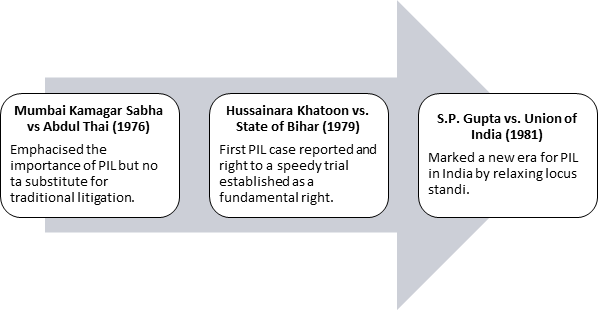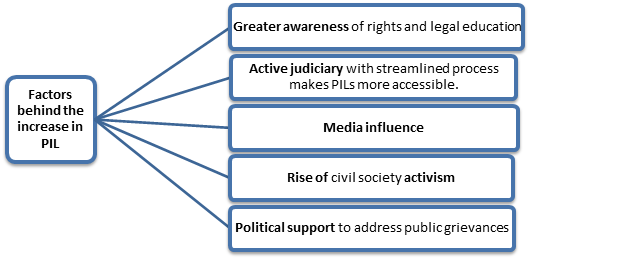About:
-
- According to SC (Janata Dal v. H.S. Chaudhary, 1993), PIL refers to legal action initiated in a court for the enforcement of public interest.
- It originated in the United States during the 1960s and was later adopted in India.

Evolution of PIL in India
Features
-
- Constitutional backing (Articles 32 and 226)
- Relaxed locus standi
- Not well defined
- Flexible procedures
Significance
-
- Expanded scope of Article 32
- Access to justice
- Strengthening the judiciary
- Driving social and political change
- Empowering marginalized groups
Landmark PIL Judgments
-
- Bandhua Mukti Morcha vs Union of India (1984)– Supreme Court ordered the release and rehabilitation of bonded laborers.
- MC Mehta vs Union of India (1987)– Established the principle of absolute liability for environmental harm.
- People’s Union for Civil Liberties vs. Union of India (1997)– Addressed custodial deaths and legal aid rights.
- Vishaka & Others v. State of Rajasthan & Others (1997)– Established guidelines to prevent sexual harassment at workplace leading to enactment of the Sexual Harassment of Women at Workplace Act (2013).
Factors behind the increase in PIL

Challenges and Concerns Regarding PIL
1. Misuse of PIL for personal or political interests rather than genuine public causes.
2. Judicial delays
3. Poor implementation
4. Judicial overburdening
5. Judicial overreach
| Issues Considered for PIL | Issues Not Considered for PIL |
|---|---|
| • Bonded labor • Neglected children • exploitation of casual workers • women’s rights • prisoner harassment • caste-based atrocities etc. | • Landlord-tenant disputes • service matters • pensions • educational admissions • requests for expedited hearings in lower courts etc. |

